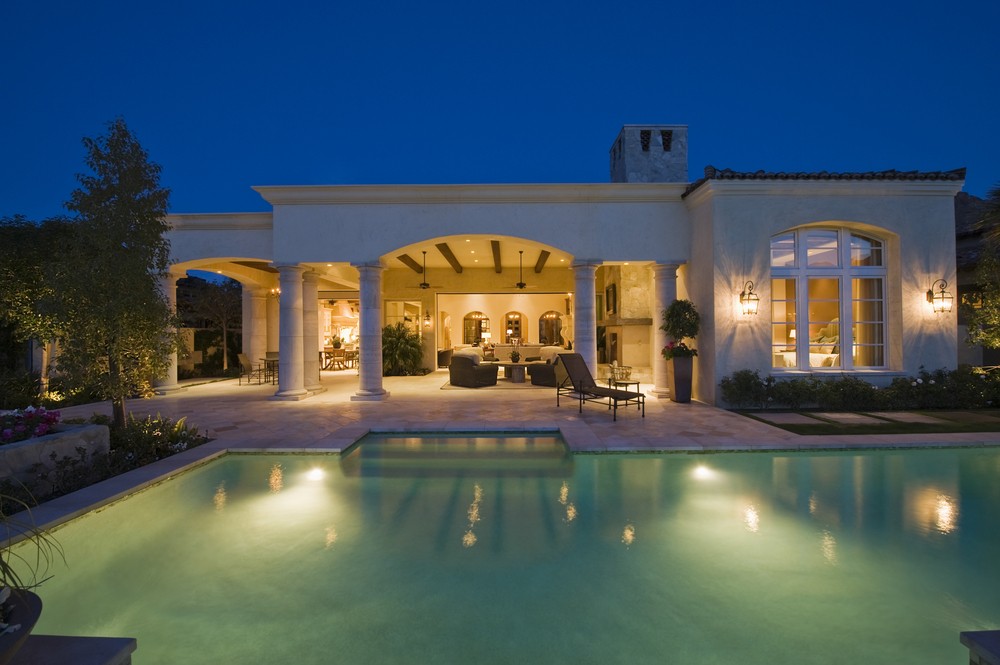Summer is here and that means it’s time for pool season! After going through all the trouble of getting your pool ready to go for summer, you’ll want to enjoy it as much as possible.
Fusion Electric wants to help you make the most out of your pool this summer, and we believe pool lighting is a great way to do just that! If you’ve been considering adding lighting to your pool, we’ve got the answers you need to know below.
Why Do I Need Lighting for My Pool?
Kansas City summers mean hot days and sometimes even hotter, more humid nights. Sometimes all you need to cool down is a nice dip in the pool. Lighting in your pool allows you to take advantage of your pool any time you’d like! Pool lighting also provides great ambiance while entertaining outdoors in the summertime.
If you’ve got little ones, pool lights can give you peace of mind if they want to swim after dark. The lights in the pool will give you better visibility so you can sit back and relax while the kiddos go for a nighttime swim!
Can Pool Lighting Be Installed in My Existing Inground Pool?
While it is possible to install pool lighting in an existing inground pool, it can become a major, and costly, renovation. We suggest installing the lights during construction of your inground pool to avoid the hassle of doing it later.
What Are My Lighting Options?
- LED Lights: LED lights are a great option for pool lighting because they have a long lifespan. They last around 30,000 hours, which, compared to 6,000 hours for fiber optics and 5,000 hours for incandescent, makes LED the obvious choice in our opinion. LED lights also have no filaments, which means they don’t emit heat.
- Fiber Optic Lights: Fiber optic pool lights are actually housed in a dry box on top of the pool patio. Light then travels through fiber optic cables, hence the name, within the pool wall where the cable ends and shines out through the pool. Although this type of lighting was popular in the early 2000’s, they have since lost their popularity with the introduction of LED technology.
Helpful Hint: One major disadvantage of fiber optic lighting is that they are by far the least bright, and they are very expensive for the small amount of light that they give off.
- Incandescent Lights: Incandescent lights emit filament, by sending an electrical current through a wire to heat up and give off light. The filament heats up producing the bright light that people associate with these bulbs.
Although incandescent lights may seem like an more affordable option, they are actually the least affordable option because of their lifespan.
Related Read: LED vs. Fiberoptic Pool Lights: Which is better?
Are They Safe?
The idea of putting anything electrical into a body of water would scare almost anyone, and in most cases it should, but that’s not the case with pool lighting. As long as they are compliant with local building codes and are properly installed according to manufacturer’s specification, pool lights are perfectly safe.
How Much Will It Cost?
The cost of full-size LED pool lights, which are what are typically installed into vinyl or concrete pools, runs from $1,000 to $1,500 to be installed. Smaller LED lights typically cost between $700 and $900 to install, depending on the brand of lighting you choose.
Fiber optic pool lights usually range from around $1,300 to $1,700 to install, and full size incandescent lights will cost between $450 and $650.
What Kind of Maintenance Will My Pool Lights Require?
The only maintenance that should be required for pool lighting is replacing the bulbs. In most cases, switching a bulb should only take five to ten minutes.
Luckily, no matter what type of light, you should never have to lower the water level to replace a bulb. Although there is some upkeep involved with replacing bulbs, maintenance shouldn’t be a major concern considering the average bulb lasts several years.
Call Fusion Electric to help with all your electrical needs at (913) 648-9487 or check out our website for more lighting tips and professional tricks.


